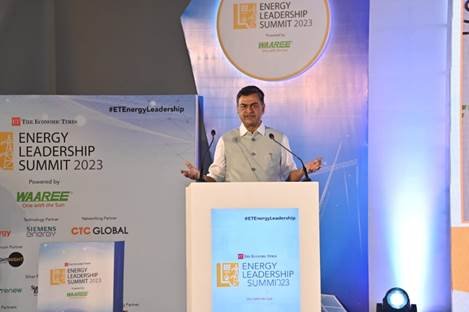Govt has come up with a policy to encourage Pumped Hydro Power Projects
The Government has been working tirelessly on energy access, energy efficiency, energy sustainability and energy security, the four pillars of India’s future in energy sector, which will include adding 50 GW capacity every year, says the Minister for Power and New & Renewable Energy R. K. Singh.
“We will add 50 GW of capacity every year. We have emerged as the fastest growing renewable energy destination,” he said while addressing ‘The Economic Times Energy Leadership Summit & Awards’ event in New Delhi 20 June 2023.
The Minister shared with the business and investor community the story of India’s progress in the energy sector and its vision for the road ahead.
Singh informed that since renewable energy storage is expensive, the government has come out with a policy to encourage Pumped Hydro Power Projects.
“Huge capacities of Pumped Hydro projects are coming up. At the same time, we need to build batteries for grid storage. We need to have another PLI scheme for grid scale storage, so that we can augment capacity and have round-the-clock renewable energy.
“We will keep adding storage to ensure that demand goes up and investment keeps happening.”
He highlighted that India has set huge targets in renewable energy. “Today, 42% of our energy capacity is from non-fossil-fuels. We have made a commitment to take this to 50% by 2030, but we shall achieve 65% of capacity from non-fossil-fuels by 2030.”
However, Singh cautioned. “Even as we build renewable energy capacity at the fastest rate, we will not shy away from adding the thermal capacity we may need in order to meet our energy requirements.
“Our pace of energy transition will be the fastest in the world, but we will not compromise with our energy needs. In 2030, I see the capacity crossing 800 GW, and that is at a conservative rate of growth.”
The Minister reminded the audience that India’s per capita carbon emissions is around 2 tons while the world per capita average is around 6 tons. India’s historical contribution to global emissions has been only 4% despite being the fifth largest economy and home to 17% of world’s population.
The Minister said, “We look at the need for energy transition because the government believes in the need for leaving a healthier planet for future generations.
“Underlining the need to move to Net Zero and not a low-carbon future, the Minister stated that we cannot afford to add any more carbon dioxide to the atmosphere.”
The Minister said that the Indian economy will keep growing at the current rate for 2-3 decades, and the Government will keep meeting energy needs to ensure this growth.
“We are adding more and more charging stations, we want to reduce dependence on foreign sources of energy, he said, underlining the need to prioritize green hydrogen for the country.
“We need to reduce importing coal for blending. We need to strengthen our logistics from coal-bearing areas and also exploit our coal reserves, for which we are auctioning coal blocks so that our dependence on imports reduces.
“Our feed stock too has to transition, for which green hydrogen is a priority area and a huge opportunity. We have set a target of setting up at least 5 million tons of green hydrogen by the year 2030.”
The Minister also underlined the need for diversification of supply chains, using technologies such as sodium ion.
Around 100 GW of battery storage capacity is going to come up in the coming years, out of which around 50 GW will be available for exports, he told delegates at the summit. Fiinews.com










